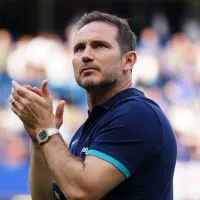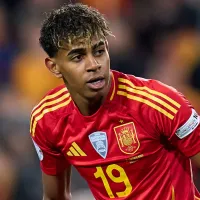I am fully aware that I am late to the why-England-were-eliminated-party here, but as I’ve pored over the litany of explanations on the web, I’ve found that there is an unfair discrepancy of player blame vs. manager blame.
Sure, the England stars appeared lackadaisical and short on ideas, but these are the same players that excel for their clubs under different systems than England’s, so blaming them can only go so far.
Somehow, Capello has failed to get the most out of his players, and that rests with the manager.
1.) Formation Was it written somewhere in his contract that Capello must employ the traditional English 4-4-2 in order to manage the national team?
As has been exhaustively written, Steven Gerrard is a waste playing in an unorthodox left-side midfielder position. When England was steamrolling through a relatively easy qualifying group, everything was rosy. But forcing arguably your country’s best midfielder out of position simply to conform to an outdated formation is naive at best, criminal at worst.
Rather than marginalize Gerrard’s talents, Capello should have built a system that showcases his abilities. Gerrard’s unique (at least for the English team) versatility has always been his downfall for the national team, yet one would think that since the FA shells out £6 million a year on the Italian “genius”, he would be able to figure out one simple notion: cater your formation to your best players, not the opposite and marginalize them.
It amazes me that fans and blog-writers can figure out that the system employed in South Africa should have seen Gerrard somewhere in the middle, yet Capello only did so when his God-send Gareth Barry was out injured (more on that later). The sad part is there are a multitude of ways in which to do execute this:

The above is just one example formation that Capello should have used in this tournament, but shockingly this was never fully implemented on a large scale by Capello nor his predecessor Sven-Goran Eriksson. In it, Lampard and Gerrard are utilized in formations for which they excel at club level (yes I know Gerrard had an off season this last campaign, but that could be attributed to injury and Rafa Benitez using him where? You guessed it, on the flank).
This is the primary system that Chelsea employed in the glory years of Mourinho, and the formation that Carlo Ancelotti reverted too after testing a midfield diamond. Manchester United has used it to great effect, with Sir Alex Ferguson realizing he lacked a second world-class striker to complement Rooney. Rooney went on to score 34 goals this past year for United, so it is hardly inconceivable that he would shine under such a system for England.
Because Capello was convinced that a Lampard-Gerrard central midfield pairing would not work (which barely anyone contests), Gareth Barry was always going to be in the starting XI as a holding player screening the back four. So why not allow both Lampard AND Gerrard to operate in their familiar positions?
For Lampard, the above system puts him right where he operates for Chelsea, allowing him freedom to attack the box with Barry behind, and positions Gerrard closer to Rooney where he needs to be because those two are the best England have on the ball. Gerrard could serve as a second striker in most attacking situations knowing that Lampard would carry out more defensive duties to help Barry if necessary.
Perhaps I am naive (also not inconceivable!), but does this not seem a formation that would get the best out of all the players on the field? It puts Joe Cole, Aaron Lennon, Gareth Barry, Frank Lampard, Steven Gerrard and Wayne Rooney in comfortable positions that mirror their club responsibilities
2.) Personnel
Heskey, Heskey, Heskey. I still am not convinced starting the big battering ram was a wise choice, and it would be hard to continue to argue such after this tournament. Short tournament campaigns like the World Cup require goals to win, and Heskey simply wastes a spot.
It is shocking to me that Capello would take a nomad footballer in the doldrums of his career and put him in the biggest show on Earth. Does he seriously think Emile Heskey is good enough to make his squad, let alone configure how he would use Wayne Rooney, England’s great hope, based on Heskey? It is complete crap. No one can sit there and look me in the face and say that Peter Crouch could not do as well as Heskey in opening up space for Rooney. Crouch provides more options than Heskey. He drops deep to open up space, he can play as a target man late in matches, and, oh wait, he actually scores goals (21 goals in 38 England matches to be exact)!

But Capello’s worst personnel decision was leaving Joe Cole to rot on the bench. England have almost no technically gifted footballers other than Cole, and Capello’s asinine decision to start an inexperienced (yet promising) James Milner over Joe Cole is indefensible. Why start yet another strong, direct type of player when pretty much the whole team is comprised of such guys? Cole brings much needed guile, style and creativity that, like John Terry famously pointed out, is one of few Englishmen that can actually open up defenses. Cole was the player of the 2006 World Cup for England, and was completely misjudged and misused by a stubborn and incorrect Fabio Capello.
3.) Man Management
While Sven-Goran Eriksson gave England the Baden-Baden WAG fiasco, Capello gave England boredom and a misplaced authoritarianism. Capello must have forgotten he is no longer a club coach, and while his attempts at Mussolini-esque autocratic rule throughout qualifying (where he sees the players once every so often) were met with enthusiasm by the British press, such attempts failed him once he had England for over a month where personalities can clash.
Granted, John Terry’s attempted “coup” was ill-advised, but it underscored the feelings of many England players at his managerial style. It highlighted that there was a major chasm between players and management, and perhaps severe lack of communication. The blame must rest with the manager for not having the full faith and confidence of the players. There was a lack of unity in the team, and while the players should never go blameless for such disharmony, the manager should be pointed at for not getting his messages across.
At the end of the day, the aforementioned three reasons are enough for Capello to be fired by the FA. He didn’t do his job. In fact, he did worse than the much-maligned Eriksson, who took his team to the quarterfinals in every major competition.
Capello comes off as a stubborn disciplinarian whose tactical acumen (at least at international level) was grossly overrated. While the players could have and should have played with more confidence and clarity, much of England’s failure was down to poor planning and poor managerial execution of solid game plans. In the Germany match, Capello played into their hands. He should have matched their formation with a similar one like above, and should have had Gerrard in a central role (where he excelled against the USA) throughout the tournament.
In the high-stakes world of international tournaments, if you underachieve as Capello has (especially at his exorbitant salary), you should get the sack. Perhaps it is time for England to go back to an English manager.
It is almost as if the FA concede that England are not good enough to win a World Cup without a foreign, tactical “genius.” Well, a Swede and an Italian have gotten them nowhere. Maybe it’s time to go back to square one.
[polldaddy poll=3410500]














